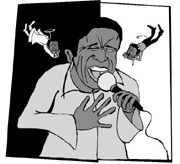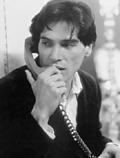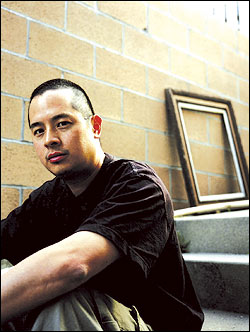LEAVE IT TO THE ultimate soul singer to sum up the dichotomy central to his profession more succinctly than anyone has before or since. Al Green’s 1977 hit, “Belle,” finds him addressing the song’s title character about a choice he’s faced with—her or God. It’s no contest: “It’s you I want, but it’s Him that I need,” he sings.
Take Me to the River
by Al Green, with David Seay (Harper Collins, $25)
That line has, of course, been quoted endlessly, as it will continue to be— writers attempting to grapple with the slippery author of those words simply have no choice but to quote them. In those 10 syllables, Al Green says everything he and every other soul singer have spent their lives and careers struggling with. And one reason Green is the ultimate soul singer is that he has grappled with that dichotomy more visibly than any other, having spent the early ’70s as black music’s biggest star only to turn to God full time in 1979, when he left pop music altogether to minister at the Memphis church he’d bought a couple years previously.
The other reason Green is the ultimate soul singer is far more straightforward: He possesses the most purely gorgeous voice ever laid to tape, a honey-dripping instrument astounding in its sheer erotic power. “Almost since I can remember, women have wanted to get next to me,” he writes in the introduction to his new autobiography, Take Me to the River. “And when I sing, it’s like they’ve received a personal invitation.” (I read that passage to a straight male friend, and his response echoed my own: “Hell, the first time I heard Al Green, I wanted to get next to him.”)
As that passage suggests, Green is also highly self-aware. That he manages to be so without being self-conscious is what makes his persona so complex and fascinating—and, because his music embodies that persona so thoroughly, he’s also a complex, fascinating artist. Such self-awareness is one of the most satisfying aspects of Take Me to the River. Most pop-music autobiographies serve as either poorly written confessionals or poorly rewritten press releases, sprinkled with a couple of titillating never-before-known factoids and complete with amateurish cover art. Green’s book, as ghosted autobiographies tend to be, falls into that trap on occasion (the dust jacket is, indeed, terrible). Cowriter David Seay’s unsexy job is to provide continuity and thumbnail historical annotations; when River‘s prose gets boxy, you can be sure it’s the cowriter’s doing.
But much of the time Seay does his job right. Most of the book is unquestionably written in Green’s voice; it’s right on the page, down to the inflections that critic Robert Christgau nailed when he described the singer as “down-home, ersatz formal, and cute.” These characteristics fuse most perceptibly when he switches from first to third person (“Al Green was on the scene. And his life would never be the same again”). Green has obviously spent a lot of time inside his own head, and that’s where much of this book takes place. Anyone who’s followed his interviews or seen him onstage won’t be surprised by Take Me to the River‘s ruminative nature, which seems only to have intensified with his acquisition of a (literal) pulpit.
GREEN’S TENDENCY to mull over a story at length, as you might expect, is tempered by putting his own story on the page. But it’s still there—and what’s more, it proves valuable. Unlike the books it most resembles, the flinty, crafty Chuck Berry: The Autobiography and Ray Charles and David Ritz’s entertainingly straightforward Brother Ray, Take Me to the River doesn’t even try to give equal weight to each part of its story. Instead, Green dwells on his early life, spending the majority of the book on his childhood in Arkansas and his teens and early 20s in Grand Rapids, Michigan.
In a contrary mood I might suggest this imbalance is the result of Green talking so much about his early life that he just rushed through the fame years of the ’70s and skipped the last 20 years altogether (“Maybe another book,” he half-promises by way of apology). The exceptions are pretty much what you’d expect them to be: his 1973 born-again experience in an Anaheim hotel room, and the infamous incident the following year when his lover (unbeknownst to him, a married woman with children who’d abandoned her family) threw a pot of boiling grits at his back and then killed herself.
But the author’s voice is so compelling, it’s hard to complain—it’s a pleasure to read the story of a man who knows himself so well. And anyone who’s identified with the emotional neediness of his music will be intrigued by what he says about his relationships with women—in particular, his liaison while in his early 20s with a Grand Rapids prostitute 10 years his senior named Juanita:
Of all the pet names Juanita had for me, I liked “pretty little boy” best of all, and it gave me a pampered, lazy feeling to think of myself as her most prized stuffed animal, the one she wanted to hold as she drifted off to sleep in the gray light of morning after a long night.
Such an admission is startling in any context, particularly when issued by a practicing reverend. But it’s crucial in understanding Green as an artist. Elsewhere, he compares Juanita to an earlier mentor, the gospel-singing Mother Bates. “They are like two magnetic poles, forces that keep me in balance between them.” Take Me to the River‘s great triumph is how well he communicates that balancing act—even if its readers aren’t necessarily struggling with it themselves.
Al Green plays the Paramount Theater on Thursday, October 5.








